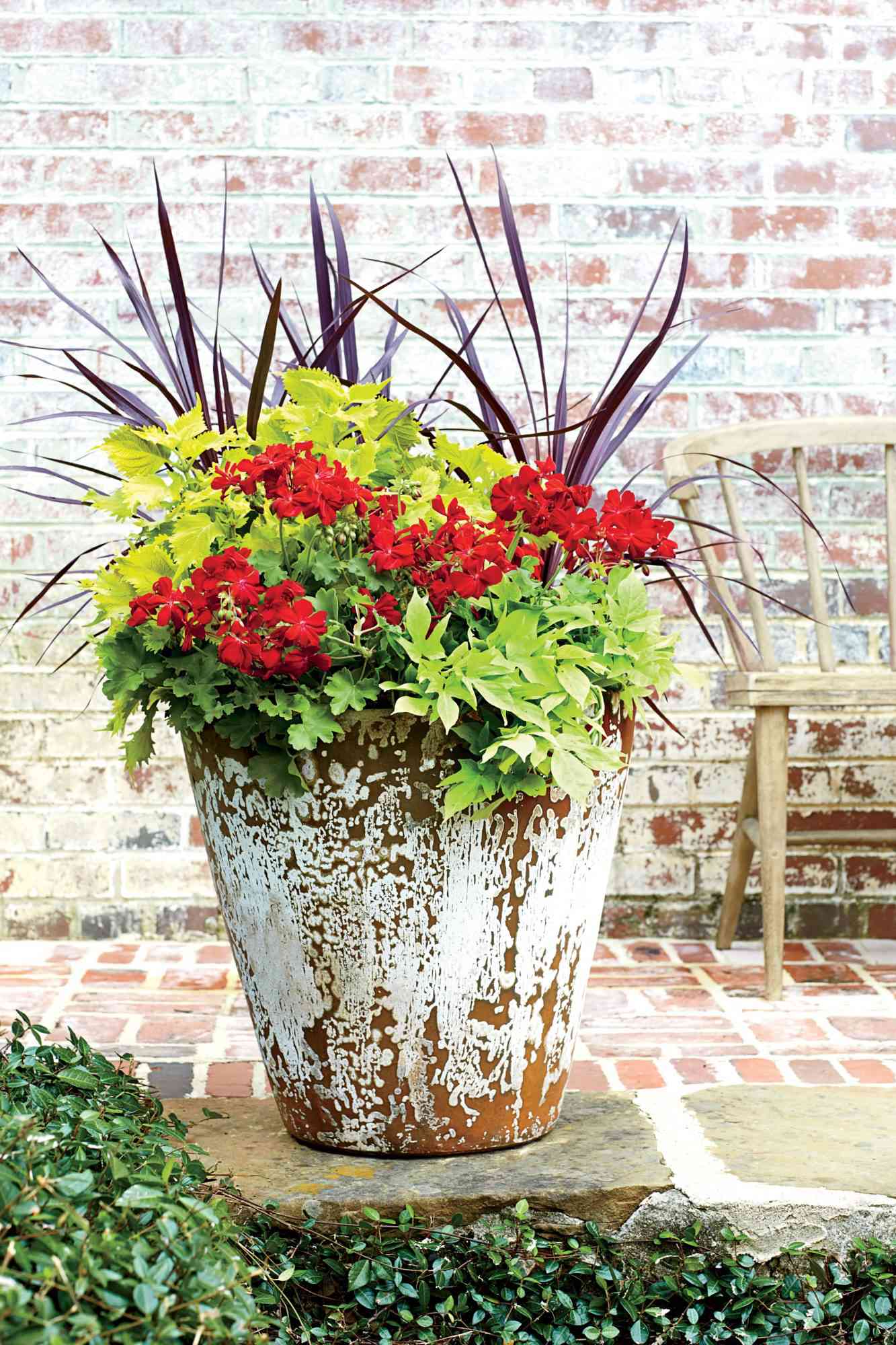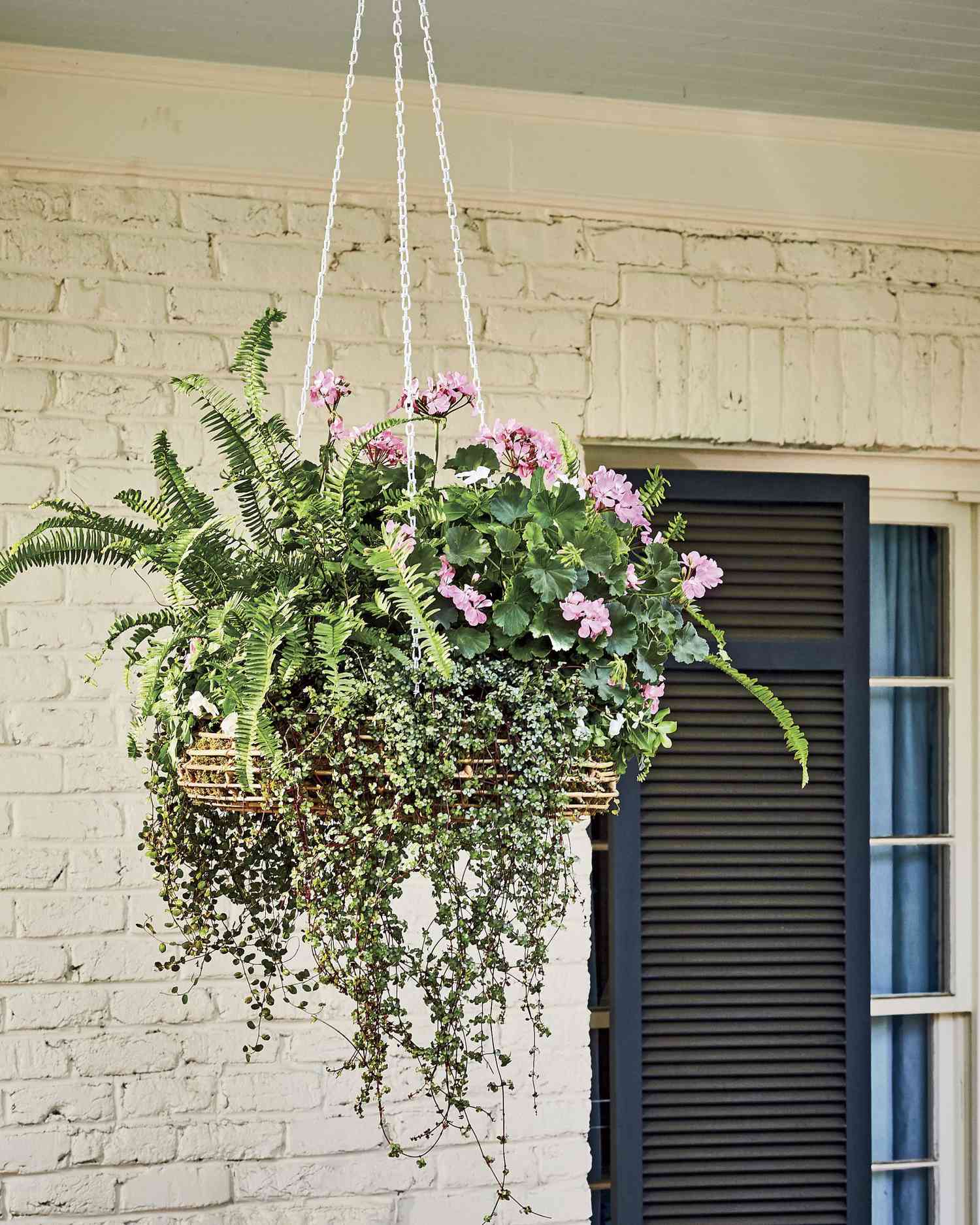Few flowers look as good in a pot as these do. They blend handsome foliage with large clusters of show-stopping blossoms in colors of red, pink, rose, salmon, orange, lavender, violet, or white. Although many people use geraniums as bedding plants, we think they perform even better in containers. Read on for geranium container ideas and how to care for these gardener favorites.
| Geranium Plant Attributes | |
|---|---|
| Common Name | Geranium |
| Botanical Name | Geranium |
| Family | Geraniaceae |
| Plant Type | Perennial shrub |
| Mature Size | H 48″ W 36″ |
| Sun Exposure | Full sun |
| Soil Type | Well-drained, neutral to alkaline |
| Soil pH | 5.8 to 6.5 |
| Bloom Time | Spring to Fall |
| Flower Color | White, red, pink, purple, mauve, orange, and reddish-black |
| Hardiness Zones | 9-11 |
| Native Area | Subtropical Southern Africa |
| Toxicity | Toxic to pets |
Types Of Geraniums
If you search enough garden centers, you can probably find four or five different types of geraniums. Two, however, account for almost all of the sales. The first and most popular is the common geranium (Pelargonium x hortorum). It’s also sometimes called a zonal geranium because its rounded, velvety, green leaves often contain a burgundy ring.
Most gardeners treat common geraniums as annuals, but in the Coastal and Tropical South where it doesn’t freeze, they’re perennials. Succulent stems become woody with age, and plants grow into picturesque shrubs. Outside these areas, you must store the plants indoors near a window during winter if you wish to grow them this way.
The second most popular type is the ivy geranium (P. peltatum), named for its glossy green, ivy-shaped leaves. Rather than growing upright like common geraniums, this one cascades. Use it to plunge from hanging baskets, window boxes, or the edge of a big planter.
How To Grow
Geraniums like fertile, well-drained soil that contains plenty of organic matter. Let the soil go slightly dry between waterings, wetting only the top inch of soil. Make sure the container has drainage holes to prevent the soil from getting soggy.
Since geraniums are relatively drought-tolerant, they may rot in soil that is too wet for too long. Don’t overfertilize: Feed them with slow-release, granular fertilizer once in spring or with a liquid 20-20-20 fertilizer three times during the growing season. Remove faded flowers regularly to keep the plants blooming. The best exposure is full sun in the morning with light afternoon shade.
Good To Know
High summer heat can take its toll on these plants. Many common geraniums stop blooming in sizzling weather, a condition known as «heat check.» (They’ll resume blooming when cooler weather arrives.) To avoid this, grow heat-tolerant types, such as the «Americana», «Eclipse», «Fidelity», «Maverick», and «Orbit Series».
Ivy geraniums like high heat even less; they do better in the Upper and Middle South. However, the heat-tolerant «Blizzard», «Cascade», and «Summer Showers Series» perform well in much of the Lower South. So does «Sofie Cascade.» In the Coastal and Tropical South, use ivy geraniums as winter annuals.
How To Overwinter Geraniums
These types of geraniums are winter hardy in USDA zones 9-11. Before the first frost, bring your container indoors and place in front of a sunny window for at least six hours per day at a temperature above 50°F. Or let them go dormant in a cool, dark place where they won’t freeze, like the garage.
Let the soil dry to barely moist, and remove dead leaves and flowers and any rot. After the last frost in the spring, place the pot outdoors each day, slowly exposing it to more sun, to acclimate the plant to warmer temperatures and resume watering. Once the temperature is above 50°F at night, resume feedings.
Watch For Pests
If your plant has buds that won’t open or you see tattered petals, your geranium could have an infestation. Common pests include aphids, spider mites, and whiteflies. Spray with neem oil to treat.
Container Ideas
Growing geraniums in containers allows you to move them when necessary, whether to provide relief from the heat, save them from frost, or bring them indoors for a splash of color. They also pair nicely with other plants.
Tabletop Geraniums
Combine red geraniums with spearmint and white sweet alyssums in a metal toolbox. This rustic container can be a centerpiece during the meal and moved throughout the garden as the season warms. Bring it inside when the weather cools.

Built For The Heat
A tall weathered container is the perfect setting for showy geraniums. «Dark Red» Calliope geraniums stand out against shades of lime greenery and purple grass. This hybrid variety holds its own against humid Southern summers.

Hanging Geraniums
Combine geraniums and ferns in a wicker hanging basket for a welcoming display on your porch. «Kimberley Queen» fern pairs with pink geraniums for the quintessential Southern grouping. Cascading «Aquamarine» pilea spills over the sides.

Stair Trio
A trio of similar containers holds cheerful hues sure to brighten your entryway. Each pot features one bold color, like the «Caliente Pink» geraniums, «Surfinia Rose Veined» petunias, and «Techno Heat Light Blue» lobelias. Greenery adds filler and interest, but the flowers are the star here.

Basket Of Blooms
Wicker baskets add height and texture to a container garden. As they weather from exposure to the elements, they’ll gain a charming, rustic look. Fill the bottoms of the baskets with empty recycled plastic bottles, and line the sides with sheet moss and landscape cloth. Add soil and a mixture of plants, like the geraniums, Profusion zinnias, and «Truffula Pink» gomphrenas in the top basket. The bottom basket combines «Glitz» euphorbias, begonias, and «Surdiva» scaevolas.
«Plant Some Geraniums» is from Southern Living’s Container Gardening.